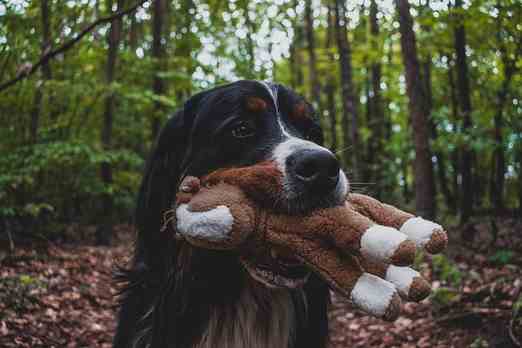All dogs need early socialization and training especially large and imposing breeds, that’s why crate training a Bernese Mountain dog is always a great idea at a younger age.
Berners that are crate trained at an early age, tend to be more obedient and more independent. Although it’s a large breed the Bernese mountain dog is always eager to please its owner and will do well in training.
The breed is in the working category of dogs and needs at least 30 minutes of moderate training every day, so it’s not the kind of dog that would spend the day in the crate.
The Bernese mountain dog is generally reserved with strangers so crate training is a great option if you have regular company, but it’s a great family dog that gets attached to one human in particular and we call him the lucky one.
What you need to crate train a Bernese mountain dog
Crate training a Bernese mountain dog is the same process as any other breed, you need the same tools to make it happen efficiently.
You obviously need a crate that fits your dog perfectly and we’ll get into the details in a moment, you need some toys and treats as rewards and lures to speed up the process.
So let’s see those three tools and how to use them to crate train your puppy perfectly.
The best crate for a Bernese mountain dog
When choosing a crate for your dog it is important to take into account the size and personality of your dog.
Size matters the most because for a dog to be crate trained properly he needs to establish a home-like relationship with his crate which he can’t do if it does not fit.
The material of the crate will vary depending on the aggression of the dog and how big he is, an aggressive large dog with separation anxiety will surely not be safe in a plastic crate for example.
So what’s the perfect crate size for a Bernese mountain dog?
Before you can choose the perfect sized crate for your Bernese mountain dog, we need first to know how big should a crate be.
The crate needs to be large enough for the dog to stand in it without touching the top side, to turn around easily and lay down without touching the front or rear parts and that’s it.
It has to be a few inches larger than your dog but not too large, or else your dog will sleep in one corner and make the other corner as a potty corner.
When fully grown a Bernese mountain dog can stand over 27 inches at the shoulder, which is very large, that’s why we recommend a 48″ crate with the following dimensions 49” L x 30.5” W x 34.25” H.
We strongly recommend a wire crate for more safety, since Berners are large and strong, and also because it’s better for crate training.
The one we recommend is the 48″ Midwest Ultima Pro dog crate (Check current price at Amazon) it comes with a divider so you don’t have to change crates as the puppy grows, you can just adjust the size.
The best training treats and toys for a Bernese mountain dog

Treats can be an important aid in training, but giving too many can cause obesity, that’s why you need low-calorie small-sized treats for crate training your Bernese mountain dog.
We recommend using Zuke’s Mini Naturals Training Dog Treats (check current price at Amazon) they come in small bite-size which is great for controlling the quantity and it’s made of natural ingredients.
For the toys, you need a chew toy and the best one is the Kong (have an extra chew toy available when the older one gets too mangled you should immediately retire it) and some interactive toys for some activity before going into the crate.
Now that you’re all set and ready to start the actual training let’s get to the steps to follow for the best results.
Step 1 Introducing your dog to his crate
The first and most important step of the crate training process is the introduction to the crate, like any relationship, first impressions are important.
Make sure your dog is introduced to his crate early in the morning so he can get plenty of time to get used to it before it’s night and it’s time to sleep in it.
Never introduce your dog to something when it’s time to do it, this my doctrine in dog training in general.
You can start by taking your puppy in a circle around the crate and let him sniff around, dogs are curious by nature so he’ll eventually show some interest and will try to get in, and when he does he’s ready for step 2.
Step 2 Exploring the crate using treats
At this early stage of the crate training process your Bernese mountain dog will do much better in a wire crate, it has a lot of open space and the dog can actually see you even inside.
You can toss a treat in the crate and use it to lure the dog inside, and once inside you need to reward immediately with another treat and praise heavily.
Just repeat this same process a few times, Bernese mountain dogs like to be praised and love to please their owners, and that makes crate training easier.
Dogs are smart and love treats and they’ll soon work it out and start to get inside the crate on their own to get the treat/praise and that’s a very good sign that your puppy is ready for the next step.
The double door crate we recommended is especially great at this step and makes it easier for your Bernese mountain dog to explore it.
Step 3 Making the crate great
Now that your dog has no objections to being in the crate, it’s the perfect time to start working on that relationship by associating being inside the crate with happy feelings and good experiences.
The best tool for bonding with the crate is food, the feeding time must be associated with the crate, so serving the meals inside is the way to go.
You don’t have to close the crate just put the food in it and let your dog get in to feed with the crate door open.
While distracted you can gradually close the door but keep an eye on his reaction, you also want to stay close to the crate while your dog is feeding to make sure he doesn’t feel trapped and you can open the door in that case.
Step 4 Spending time in the crate closed
At this step of the process you want your Bernese mountain dog to spend some time in the crate after his meal.
The best way to achieve that is to keep your dog distracted and that’s why you need a puzzle toy like the kong, it does such a great job keeping the dog busy he wouldn’t even notice that you’re no longer there.
Gradually increase the time your dog spends in the crate after his meal and stay close at first until he gets used to spending at least 30 minutes in there after the feeding time.
You can leave the room for a couple of minutes at a time and walk right past the crate every now and then so the dog knows that even if he can’t see you he is not alone.
If your puppy is doing ok and not whining in his crate you can increase the time he spends alone in his crate.
Step 5 Home alone
Now that your Bernese Mountain dog is spending time alone in his crate closed with you away from the room you can proceed to the final step, which is leaving your dog home alone.
Before you do that there are a couple of things you need to be aware of, don’t make a scene out of leaving, and when coming back.
Before you leave stop interacting with your dog five minutes earlier at least and there is no need to say goodbye just leave.
Making a scene will only associate being in the crate with being left alone and we don’t want any bad feelings associated with the crate.
And the same thing goes for when you come back, don’t start greeting your dog right from the door, give it a few minutes.
You also want to start by small periods of time no more than 30 minutes just in case and according to the age of your dog it can be as long as a couple of hours or more for adults.
Crate training a Bernese Mountain dog at night
When crate training a Bernese Mountain dog at night it’s the first night that counts, that’s why you need to start early to give your dog plenty of time to adjust.
Generally, dogs are more willing to accept the crate at night especially if they do get enough activities during the day.
Preparing for the night would be best by playing some interactive games and feeding and doing the business just before sleep.
It is best to stop giving water to young puppies at least two hours before bedtime, to reduce the number of times the puppy needs to go for a break.
In case of whining don’t be alarmed it’s totally normal, generally ignoring it works fine if not just make a sound or tap gently on the crate to distract him, and do not let the dog out.






